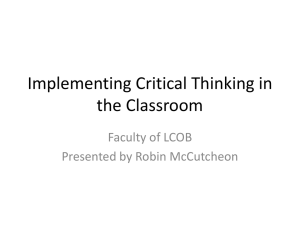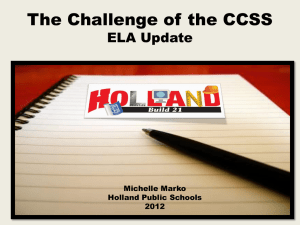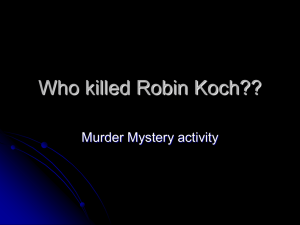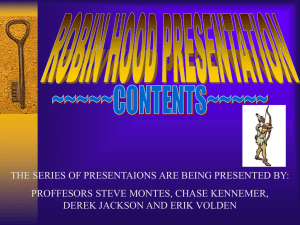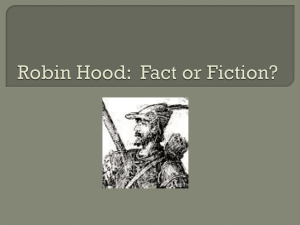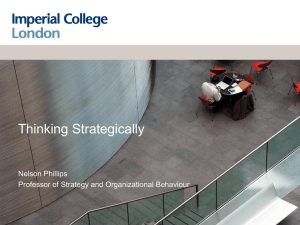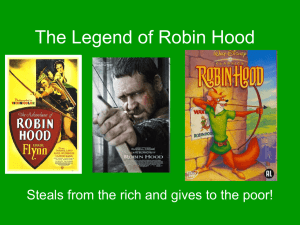Getting Good at Grants - NorthSky Nonprofit Network
advertisement
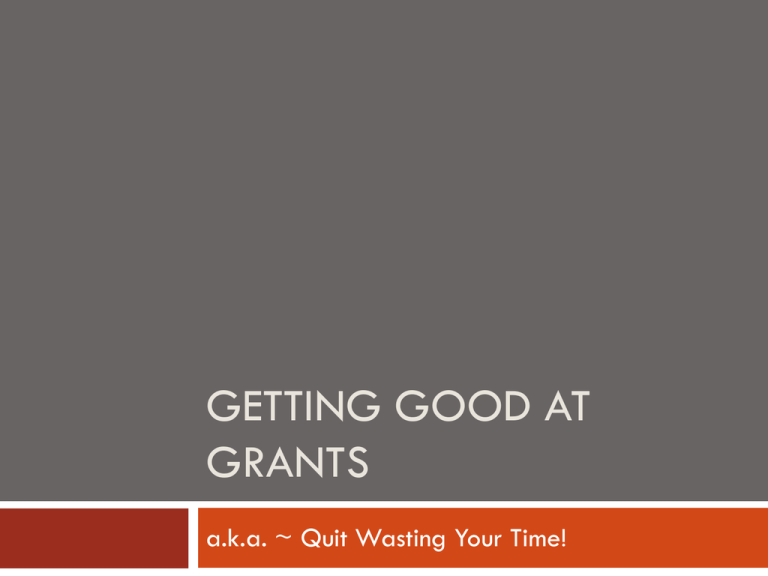
GETTING GOOD AT GRANTS a.k.a. ~ Quit Wasting Your Time! Our Goals for Today 2 Highlight Good Habits and Better Systems Internalize What The Experts Tell Us Create A Better Sense of “The Plan” Raise Your Comfort Level Robin Lynn Grinnell - robin@grinnellconsulting.org The Agenda 3 Grant Seeker’s Top 10 From the Proverbial Horse’s Mouth Lunch Let’s Write! Your Plan Robin Lynn Grinnell - robin@grinnellconsulting.org Learning Management 4 Break times and lunch Restrooms and so forth Quiet those dastardly cell phones Minimize side conversations Challenge appropriately If you hear it more than once, consider it emphasis Enjoy the day! NETWORKING 101: Who is here?? Robin Lynn Grinnell - robin@grinnellconsulting.org Get Your Head in the Game 5 Take out a piece of paper Answer these three questions: 1. 2. 3. What do I need to find funding for? What is one specific program/activity I can FOCUS my thinking on today? Why is this program necessary? (What is the need, what will it accomplish?) Robin Lynn Grinnell - robin@grinnellconsulting.org Grant Seeker’s Top 10 6 1. 2. 3. 4. 5. Understand What You Need Allocate Time – and Stick To It Research, Research, Research Initiate (or continue) Relationships Review What’s Already Been Done 6. 7. 8. 9. 10. Assemble Your Team Follow the Directions Communicate Broadly Double Check Everything Learn From Your Mistakes Robin Lynn Grinnell - robin@grinnellconsulting.org 1. Understand What You Need 7 How much money do you need for this particular grant/project? How much of your annual budget comes from grant funding? What role do grants play in your overall fund development plan/strategies? What current environmental factors are going to impact your chance for success? Are grants the right source of funding for you to pursue? Robin Lynn Grinnell - robin@grinnellconsulting.org 2. Allocate Time and Stick To It 8 Determine the amount of time you should invest in grant seeking (research, writing, relationship development) Let’s work through a formula here… Build that time into your schedule on an ongoing basis – if raising the money is non-negotiable, the time you need to do your work well should hold equal priority Robin Lynn Grinnell - robin@grinnellconsulting.org 2. Allocate Time – Part II 9 Develop a strategy to manage all members of your grant writing team in a cohesive manner Create a submission timeline, and stick to it! Due Date At least three days prior: proposal complete and ready to mail One week prior: proposal to review team for final review Two weeks prior: draft review; financial review; internal communication for alignment and input Robin Lynn Grinnell - robin@grinnellconsulting.org 3. Research, Research, Research 10 Mission alignment - PARAMOUNT Geography and other considerations Timing This is where you should spend MOST of your time. Robin Lynn Grinnell - robin@grinnellconsulting.org Locating Government Grants 11 Michigan EGrants http://www.michigan.gov/egrants/0,1607,7-20241337_45826---,00.html Economic Stimulus - www.michigan.gov/recovery Federal Grants – www.grants.gov MSU Cooperating Collection http://staff.lib.msu.edu/harris23/grants/index.htm Robin Lynn Grinnell - robin@grinnellconsulting.org Locating Foundations 12 Council of Michigan Foundations Grantseeker Resources http://www.michiganfoundations.org/s_cmf/sec.asp?CI D=516&DID=2541 The Foundation Center http://foundationcenter.org/getstarted/nonprofits/ MSU Cooperating Collection http://staff.lib.msu.edu/harris23/grants/index.htm Robin Lynn Grinnell - robin@grinnellconsulting.org Things to look for: 13 Annual Report(s) Current and past grantees 990-PFs Current/Recent Funding Guidelines Even if they’re outdated, they can give you a framework from which to work Name of a Program Officer Summaries, Abstracts, or examples of great proposals (http://www.tgcigrantproposals.com) Robin Lynn Grinnell - robin@grinnellconsulting.org Foundation Support for Grantseekers 14 C.S. Mott Foundation http://www.mott.org/resources/overview.aspx Includes samples of all forms that grantees may have to submit W.K. Kellogg Foundation Knowledge Center http://www.wkkf.org/knowledge-center/knowledge-centerlanding.aspx Includes toolkits for communications, evaluation and policy Robin Lynn Grinnell - robin@grinnellconsulting.org 4. Initiate (or continue) Relationships 15 Call potential funders and make a friend – be nice to the person who answers the phone! Ask to speak to a program officer with specific questions (no fishing expeditions, please) Ask for 10 minutes to share the outline of your idea and gather opinions on relevance and fundability Ask for recommendations of resources for you to review Ask for evaluation reports and/or other resources recommended by this particular funder to inform your planning and program development Robin Lynn Grinnell - robin@grinnellconsulting.org 5. Review What’s Already Been Done 16 Review previous proposal submissions from your organization – GOOD AND BAD Make Review successfully funded proposals from other organizations Make notes notes Gather existing data in centralized files (org history, evaluation frameworks, etc) Find the info for your other appendices Robin Lynn Grinnell - robin@grinnellconsulting.org 6. Assemble Your Team 17 Successful proposal writing is not a one-person job Financial Evaluation Human Resources External partners/collaborators Legal (to review for liability and external contracts) Program experts Other (service recipients, affected constituencies) Robin Lynn Grinnell - robin@grinnellconsulting.org 7. Follow the Directions 18 Seriously. Follow the Directions. Recognize that everybody’s directions are slightly different. Robin Lynn Grinnell - robin@grinnellconsulting.org 8. Communicate Broadly 19 Let others in your organization know you’re applying – check against fund development plan Ask for ideas and input Give key personnel (finance, evaluation, communications) a heads up – and block time on their calendar for participation Engage your constituents – focus group for program design; board members for collaboration or support, etc. Robin Lynn Grinnell - robin@grinnellconsulting.org 9. Double Check Everything 20 ONE chance to make a good first impression Spell check; grammar check Double check against application guidelines and specifications Have finance people check your numbers Have someone UNRELATED read your proposal to see if it makes sense Have someone who knows the business read your proposal for accuracy and reality Robin Lynn Grinnell - robin@grinnellconsulting.org 10. Learn From Your Mistakes 21 Don’t “mildly amend” an old proposal that was unsuccessful Ask funders for feedback on proposals that were declined and heed their advice Include organizational learnings as part of the documented need, program design, etc. - funders like programs who are honest enough to own up to mistakes, and who can demonstrate they LEARN from them Robin Lynn Grinnell - robin@grinnellconsulting.org Four Reasons Proposals Are Declined 22 From : 1. The Insider’s Guide to Grantmaking, Dr. Joel J. Orosz © 2000 2. 3. Jossey-Bass Publishing W.K. Kellogg Foundation 4. Request is a much larger amount than the foundation is willing or capable of paying. Idea lies outside the scope of the foundation’s funding guidelines. Idea is within the scope of the guidelines but is inferior in quality. Idea is within scope, of good quality, but less promising than others. Robin Lynn Grinnell - robin@grinnellconsulting.org 12 Characteristics of a Good Proposal 23 From : The applicant’s idea is innovative. 1. The Insider’s Guide to Grantmaking, 2. Dr. Joel J. Orosz 3. The applicant has expertise, but also an understanding of its weaknesses. The applicant has done the needed homework. © 2000 Jossey-Bass Publishing W.K. Kellogg Foundation But innovative is relative. a) b) About the project About the foundation Robin Lynn Grinnell - robin@grinnellconsulting.org 12 Characteristics of a Good Proposal 24 From : 4. The Insider’s Guide to Grantmaking, 5. Dr. Joel J. Orosz 6. © 2000 Jossey-Bass Publishing W.K. Kellogg Foundation 7. 8. The applicant is doing the project WITH, not TO, those it is trying to help. The applicant is other-centered, not selfcentered. The applicant will invest its own money in the project. The applicant is determined to do the project, no matter what. The applicant has devised a comprehensive approach. Robin Lynn Grinnell - robin@grinnellconsulting.org 12 Characteristics of a Good Proposal 25 From : 9. The Insider’s Guide to Grantmaking, 10. Dr. Joel J. Orosz 11. © 2000 Jossey-Bass Publishing W.K. Kellogg Foundation 12. The applicant will work collaboratively with others who can help. The applicant is willing to have an evaluator assess the project. The applicant will continue the project after foundation funding ceases. The applicant’s project has the potential for broader impact. Robin Lynn Grinnell - robin@grinnellconsulting.org What You Need to Write 26 Cover letter (or, if you’re lucky – a letter of application!) Proposal Case statement Needs statement Goals and objectives Evaluation strategy Budget Robin Lynn Grinnell - robin@grinnellconsulting.org The Proposal Format 27 A Michigan Model: Council of Michigan Foundation’s Common Grant Application & Common Report Form http://www.michiganfoundations.org/s_cmf/bin.asp?CID =2528&DID=10304&DOC=FILE.DOC Robin Lynn Grinnell - robin@grinnellconsulting.org The Proposal Format 28 Common Grant Application 1. 2. 3. 4. 5. 6. Exec Summary Purpose of Grant Evaluation Budget Narrative/Justification Organization Info Attachments NP Guides 1. 2. 3. 4. 5. 6. 7. Cover Letter Cover Sheet Narrative Budget Qualifications Conclusion Appendices Robin Lynn Grinnell - robin@grinnellconsulting.org The Narrative/Purpose of Grant 29 Common Grant Application Statement of Needs Goals, objectives, action plans and statements Timetable for implementation Partners Competition Involvement of constituents Qualifications of staff Long term funding beyond grant NP Guides Needs Assessment Goals/Objectives Methodology Evaluation Robin Lynn Grinnell - robin@grinnellconsulting.org The Proposal Format 30 Nonprofit Guides tutorial www.npguides.org The BEST way to learn to WRITE proposals is to READ them. Robin Lynn Grinnell - robin@grinnellconsulting.org Mission-critical Questions 31 What problem are we trying to address? What program are we offering to address the problem? Why is this important? Who is our market? Who are our competitors? (duplication?) What are the financial needs of supporting this initiative? Do we possess the organizational capacity to carry this through? Who should support our efforts? Robin Lynn Grinnell - robin@grinnellconsulting.org Painting the Picture 32 Statistics Reliable sources Appropriate comparisons Paint by numbers: stats can tell your story Anecdotes: short, sweet, related Focused on needs of community v. needs of organization Community voice is key Robin Lynn Grinnell - robin@grinnellconsulting.org Goals and Objectives 33 Goals are the large statements of what you hope to accomplish but usually aren't very measurable. They create the setting for what you are proposing. Objectives are operational, tell specific things you will be accomplishing in your project, and are measurable. Outputs: bean counting (immediate or short-term) Outcomes: behavioral/environmental change Robin Lynn Grinnell - robin@grinnellconsulting.org Think Term Paper Outline 34 Mission Program Goal Objective Activities Goal Objective Activities Robin Lynn Grinnell - robin@grinnellconsulting.org For Example 35 Education Program to Prevent Dating Violence What are GOALS of such a program? What are MEASURABLE OBJECTIVES of such a program? Outputs Outcomes What will SUCCESS (long-term impact) look like? Robin Lynn Grinnell - robin@grinnellconsulting.org Effective Evaluation 36 Effective evaluation answers the question, “So what?” Robin Lynn Grinnell - robin@grinnellconsulting.org Your Evaluation Strategy 37 Evaluation plans should be developed concurrently with program plans, staffing plans, funding plans to ensure that the pieces of the puzzle fit What do your wide array of stakeholder’s care about? You can’t measure everything, so focus on what matters most If you ask the question, you must be able to answer it Robin Lynn Grinnell - robin@grinnellconsulting.org Things to think about 38 Evaluation is a full-circle activity Find out which model your (potential) funder prefers AND which model works for YOUR ACTIVITY Your EVALUATION MEASURES = your objectives Key Resource: www.wkkf.org – Evaluation Tool Kit Robin Lynn Grinnell - robin@grinnellconsulting.org Typical Budget Line Items 39 Personnel (salary and benefits) Consultants (salary) Instruction Equipment Supplies Communication (telephone/postage) Materials preparation Travel Rental of facilities Evaluation Other expenses Indirect costs (costs that your organization requires) Robin Lynn Grinnell - robin@grinnellconsulting.org The Budget Narrative 40 Show Your Work (formulas are helpful) Be Realistic Check Your Addition Explain Every Line (make no assumptions) Too much detail makes you “thorough” – too little makes you “suspect” Robin Lynn Grinnell - robin@grinnellconsulting.org Aspects of Sustainability 41 Financial resources Community ownership Human resources: the people power to get it done Long-term plan of action vs. short-term reaction Robin Lynn Grinnell - robin@grinnellconsulting.org Grant Writing Resources 42 http://www.npguides.org http://tgci.com/magazine/proposal.shtml http://www.grantproposal.com/funders.html http://www.northskynonprofit.org/resource.php Books: Insider’s Guide to Grantmaking (Orosz) Grant Writing for Dummies (Browning) Robin Lynn Grinnell - robin@grinnellconsulting.org Let’s Write 43 Go back to your program you started thinking about this morning (or pick one now) Write a clear statement on how this activity advances your nonprofit mission Define 2-3 GOALS For each GOAL, define both an OUTPUT and an OUTCOME For each OUTCOME, define what you will need to do to measure/evaluate to determine whether or not you have been successful Robin Lynn Grinnell - robin@grinnellconsulting.org Questions? 44 Robin Lynn Grinnell robin@grinnellconsulting.com Robin Lynn Grinnell - robin@grinnellconsulting.org
